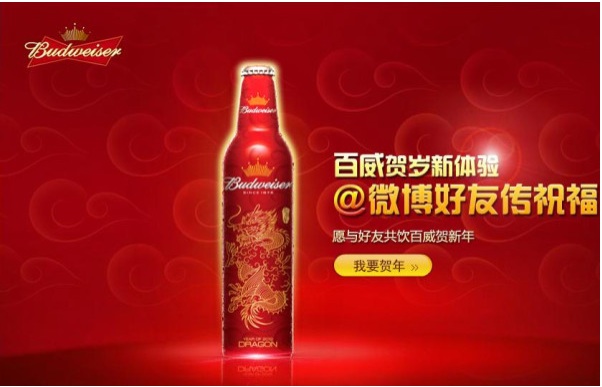品牌新聞
Like Many Expats, Bud Enjoys Being Big in China
中國大陸地廣人多,人口眾多意味著商機無限,但同時也代表任何產業在大陸競爭都相當激烈。舉例而言,中國的啤酒市場正是個充滿著機會和挑戰的最佳代表。在中國境內,一年可消費將近四百四十億公升的啤酒,幾乎是全球啤酒消耗量的四分之一。儘管中國平均每人的啤酒消耗量只有美國的二分之一,但未來的發展仍非常值得關注。據估算,未來兩年內中國啤酒市場將達到四千五百八十億人民幣的年產值,較2009年時的三千零六十億成長許多。
在競爭激烈的啤酒市場裡,「百威啤酒」則成功打響了知名度,更在中國被視為是具高品質的高級啤酒品牌。儘管百威啤酒在零售價格上較競爭者貴上兩倍,仍然讓百威啤酒持續保有兩位數的成長率及穩坐市場龍頭寶座。
然而,近來中國貧富差距日益擴大,人民對「高檔」的字眼感到反感。因此未來百威啤酒在中國的發展將著重於品牌形象的塑造,以確保在中國大陸的發展。
They "tend to drink beer more often at restaurants, bars and other entertainment venues, and they like to consume large volumes over a short period of time."
That quote was not about beer consumption habits among US college students, but about those of the Chinese. Speaking to The China Daily, Carlsberg China CEO Stephen Maher described China's market for beer in that oldest of Chinese tropes: "a challenge and an opportunity."
One such opportunity is a familiar one to foreigners in China: the chance for a schlub to be a star -- just for being foreign.
Not many in the west would ever describe Budweiser as a luxury beer brand, but in China, it's a premium label retailing for more than twice some of its competitors. A spokesperson for Bud parent InBev told Bloomberg that the "premiumization trend continues with double-digit growth and Budweiser is further consolidating its leading position within this segment.”
For brands like Budweiser, Miller, Heineken and Carlsberg, China represents a booming growth industry where their brands are considered premium, luxury quality. It's a far cry from what's happening back home, where the thirst for craft beers have driven down Bud sales. Miller Genuine Draft recently launched in a few China test markets even as the brand lost US market share to smaller labels like Sam Adams.
Note to the big brands: Yes, the microbrew revolution is already hitting China.
Chinese drink about 44 million kiloliters of beer annually, nearly a quarter of the global total. And while China's per capita beer consumption is only half of America's, its trajectory is far more exciting. In the next two years, the China beer market is predicted to hit 458 billion yuan ($76 billion), an increase from 2009's 306 billion yuan ($51 billion). Better yet, as The China Daily pointed out, while "the sector may have made up just 10 percent of overall sales in 2011 (a rise of 20 percent on the previous year)… it contributed almost 50 percent of total profit."
To corner this market, brands like Carlsberg have launched speciality labels for China. For example, Carlsberg Chill tones down the brew's bitterness and cranks up its youth.
Though Budweiser may be basking in its luxury label, the brand would be wise to be careful in its newfound status. In many ways, "luxury" has become a dirty word in China, where wealth disparity is a sore point. Iconic Chinese wine brand Mao Tai recently efforted to distance itself from a study that found it in the top of China's "luxury" brands. The nation's central authority also recently decreed that it would no longer pay for Party officials to use luxury foreign autos like Audi. (It's estimated a third of all Audi sales in China are to Party officials.)
Premier Wen Jiabao recently also announced that the state would no longer spring for "high end" alcohol for official events. In a nation where the state itself is the largest consumer, Bud and other brands would be wise to be a little careful not to find themselves using the luxury label too liberally.
LINK:http://www.brandchannel.com/home/post/2012/04/10/Like-Many-Expats-Bud-Enjoys-Being-Big-in-China.aspx

